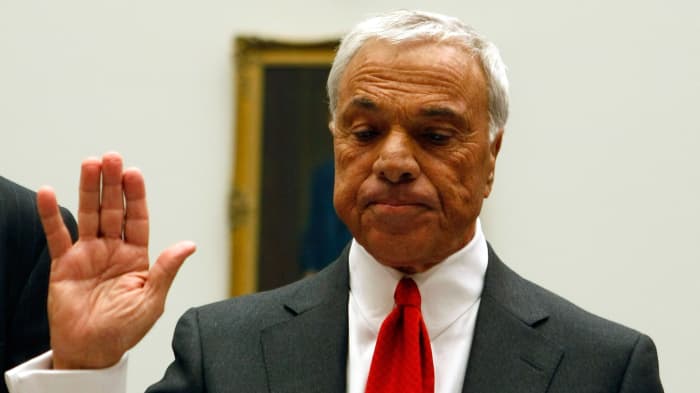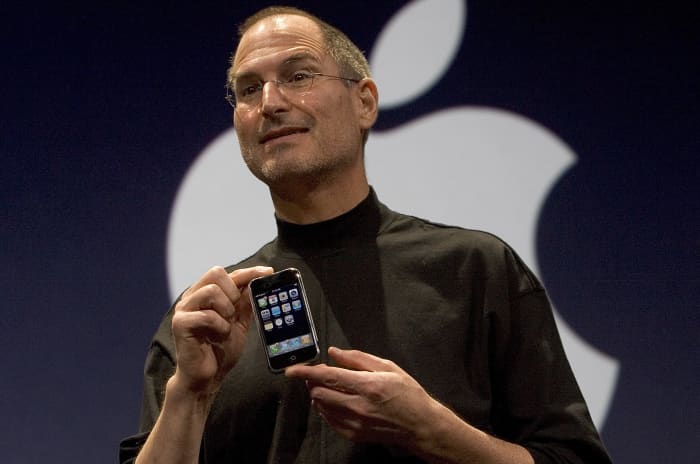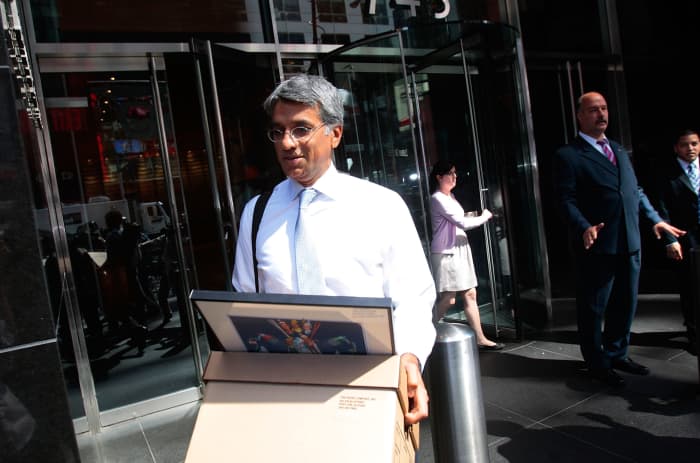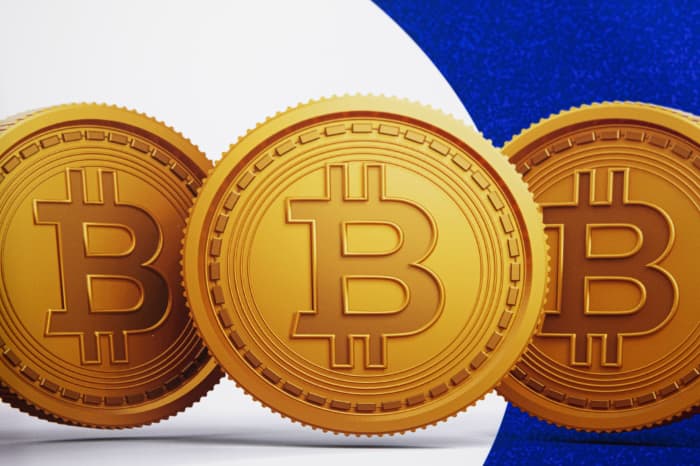We are marking MarketWatch’s 25th anniversary by looking at the 25 biggest financial market events and developments we have covered. We previously highlighted the first five key events from the early years and noted how technological change helped produce online brokers, the rise of the day trader, and the IPO boom and bust.
The first decade of the new millennium transformed Americans’ relationships with Wall Street, Washington and even their phones. Some of this change was good. But some of it, particularly financial innovation, went out of control. The crisis era brought us moments that shook financial markets to their core and set the tone for everything that has happened since.
6. The Enron scandal
AFP via Getty Images
On December 2, 2001, Enron filed for bankruptcy court protection. At the time, it was the biggest corporate failure in American history and symbolized the excesses that had taken place in financial markets. A Houston energy and trading company, Enron had started 2001 as the nation’s seventh largest company with $100 billion in reported revenue and a high-flying stock before collapsing amid accusations of accounting fraud.
Employees were quick to point the finger at Enron CEO Ken Lay and other top executives. “He had to be aware of what was going on,” one employee told MarketWatch days after the bankruptcy. “Something about this is not legal. Something, somewhere is wrong.”
Federal prosecutors agreed. They criminally charged Lay and other top executives, like Jeffrey Skilling and Andrew Fastow, accusing them of employing accounting gimmicks to cook the books and mislead investors. All three were convicted, but Lay died before his sentencing. He always maintained his innocence.
The government also charged Arthur Andersen, one of the big five accounting firms and Enron’s auditor, of obstructing justice by destroying Enron documents. “Andersen shredded ‘tons’ of paper,” as MarketWatch put it in 2002. That same year, a federal jury convicted Arthur Andersen, causing the dissolution of the firm and the loss of 30,000 jobs.
In response to the Enron scandal, federal lawmakers passed the Sarbanes-Oxley Act, requiring sweeping new accounting and recordkeeping practices for corporations. Three years later, MarketWatch ran the following headline: “Andersen’s Conviction Overturned.” As MarketWatch told it, in a unanimous decision written by Chief Justice William Rehnquist, the the Supreme Court said “the jury instructions were flawed in important respects.” But the legal reversal could not undo the end of Arthur Andersen’s accounting business.
7. The subprime real estate boom & bust

Angelo Mozilo, CEO of Countrywide Financial Corporation, raises his right hand as he is sworn in during a House hearing on March 7, 2008.
Getty Images
The Bronx-born son of a butcher, Angelo Mozilo became the perpetually-tanned face of the subprime mortgage boom. For years, his Countrywide Financial was the leading seller of home loans to people with poor credit scores who did not qualify for a conventional mortgage. Before 2000, this kind of lending barely existed. But many banks and specialty finance companies followed Mozilo’s lead, originating toxic mortgages that were then sold to Wall Street and government-sponsored entities, fueling an unsustainable increase in U.S. housing prices.
The subprime mortgage boom not only opened up the mortgage market to people who previously could not access home loans, it featured products that let them buy homes they truly could not afford. Across America people bought homes without making initial down payments, using loans that started out with artificially low teaser rates or required no early principal payments at all. Those financing terms would later reset and increase dramatically.
The erosion of lending standards was premised on the perception that housing prices only went in one direction: up. Wall Street and the federal government were happy to fuel this idea. For years, banks and government-sponsored enterprises had bought mortgages from lenders, funding their ability to originate more mortgages. The banks and GSE’s packaged the loans into securities that were sold to investors. With the subprime mortgage boom, the underlying mortgages became much riskier and Wall Street stepped up its financial engineering with ever more riskier products. But the big credit rating agencies, which were paid Wall Street fees, kept giving their highest ratings to the more risky products.
By March 2007, many American homeowners were unable to make their mortgage payments. Housing prices fell. Ben Bernanke argued that the problems associated with subprime loans were “contained.” MarketWatch reported that the Federal Reserve chairman at the time saw limited impact from subprime. “We do not expect significant spillovers from the subprime market to the rest of the economy or to the financial systems,” MarketWatch reported Bernanke saying.
8. The iPhone

Steve Jobs holds up the new iPhone that was introduced at Macworld on January 9, 2007 in San Francisco, California.
Getty Images
On the day Steve Jobs introduced the world to the iPhone in early January 2007, most of the tech press was in … Las Vegas, covering CES, the massive consumer electronics trade show. The last-minute unveil at San Francisco’s Moscone Center sent several reporters at CES into a panic, and they booked the next-available flight to the Bay Area. They were not disappointed.
Longtime Silicon Valley analyst Tim Bajarin, who was in the audience that Tuesday morning, was instantly convinced Apple would create a new category in mobile computing. “We had mini computers, desktop computers and now with the iPhone, pocket computers,” he recalled. “I felt it could be Apple’s biggest hit ever.”
In a sit-down interview with Jobs following the debut of iPhone (it would eventually ship in June), the iconic Apple Inc. co-founder initially downplayed the social and financial significance of iPhone. Then, he warmed up.
“This is a revolutionary product that has the chance to really impact people’s lives,” Jobs told Jon Swartz, now a MarketWatch Silicon Valley correspondent. Jobs compared the iPhone to the original Macintosh and iPod. “This is the ultimate digital device.”
Jobs made a convincing case, demonstrating how iPhone users could make calls while viewing content on the Web and exchanging e-mail — all at the same time.
In the 15 years since its inception, the iPhone redefined the burgeoning smartphone market, kick-started Apple AAPL, -0.98% into years of hyper-growth and made Apple the world’s biggest company by market capitalization, a title it recently lost to Saudi Aramco. Roughly half of Apple’s $365.8 billion in 2021 revenue came from iPhone sales. At the same time, developers are selling some $600 billion annually of goods and services through the App Store.
In total, Apple has sold more than 1.3 billion iPhones.
9. Lehman Brothers Collapses

An employee of Lehman Brothers carries a box out of the company’s headquarters on September 15, 2008 in New York City.
Getty Images
On September 15, 2008, Lehman Brothers filed for bankruptcy. MarketWatch bore witness to the scene outside the 158-year-old investment bank’s Manhattan headquarters, describing it as “a media circus, with cameras lined along the Seventh Avenue sidewalk and reporters approaching employees for comments.” MarketWatch was among the media mob approaching the stream of employees leaving the building with boxes in their hands.
“Several dozen people went into the Lehman offices wheeling suitcases. One of them, who said he was with the research department at Lehman, was notified over the weekend that he had been laid off. He said he didn’t know how many people in his group had been dismissed, but that he was coming back Monday morning to ‘salvage what I can’ from his office,” MarketWach reported.
Lehman Brothers collapsed under the weight of souring real estate assets, sending shockwaves across the world and sparking a financial crisis. Within hours of the bankruptcy filing, one of the biggest money market funds was forced to “break the buck,” unable to fully pay its investors because of the Lehman Brothers commercial paper it held. MarketWatch reported how the Reserve Primary Fund “put a seven-day freeze on investor redemptions after the net asset value of its shares fell below $1.”
As global credit markets seized up, the Federal Reserve was forced to guarantee money market fund assets and participate in the federal government’s $182 billion bailout of teetering AIG, the insurance behemoth. MarketWatch quoted Andy Barile, an independent insurance industry consultant based in Rancho Santa Fe, Calif. “There must be something that can be done to stop this. There are too many financial consequences.”
The federal government’s dramatic intervention in markets, which featured Congress’ $700 billion bailout law, prevented the collapse of the financial system. But the financial crisis still triggered the Great Recession, and political backlash, like the Tea Party and Occupy Wall Street movements.
10. Satoshi Nakamoto

Lauren DeCicca/Getty Images
In October 2008, during the darkest days of the financial crisis, a person using the pseudonym Satoshi Nakamoto sent an email to a cryptography mailing list. “I’ve been working on a new electronic cash system that’s fully peer-to-peer, with no trusted third party.” Nakamoto published a white paper online detailing a digital currency. He called it bitcoin.
The true identity of Satoshi Nakamoto remains a mystery, but the technology he introduced has had a profound impact on markets. Bitcoin BTCUSD, -1.05% popularized the idea of digital currencies powered by distributed software known as blockchain. There are now more than 12,000 digital currencies with a combined market capitalization of nearly $2 trillion. Bitcoin is still the most widely traded and highly valued.
It took a while for MarketWatch to catch onto the significance of bitcoin. Chuck Jaffe, a columnist, first described bitcoin for MarketWatch readers in 2011 as “a new form of currency that is not tied to any country or government, and that doesn’t actually exist in the physical world.” Jaffe noted that “the bitcoin system is run by the people who use it,” and added there are “no government officials to step in and mess things up.” He also compared it to tulips and Beanie Babies and suggested investors “still favor stocks and bonds and other investments.” At the time, bitcoin changed hands for $10.
Since then, bitcoin has been bid up above $40,000 and been mentioned in 5,300 MarkeWatch articles. The tickers of cryptocurrencies are among the most popular on the MarketWatch site. We even have a reporter dedicated to covering bitcoin and other digital currencies.

